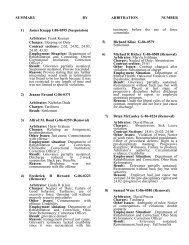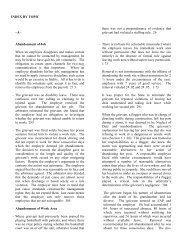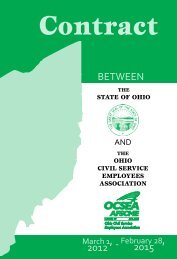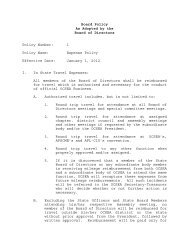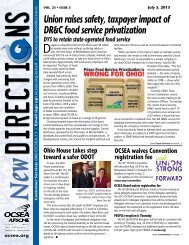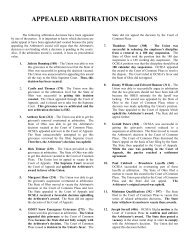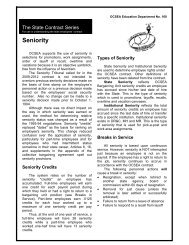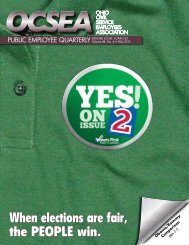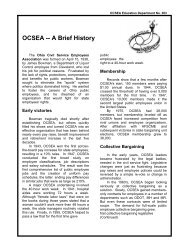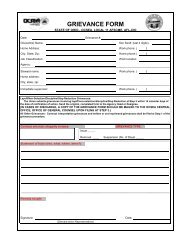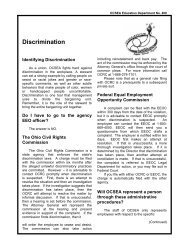by Contract Number (PDF) - OCSEA
by Contract Number (PDF) - OCSEA
by Contract Number (PDF) - OCSEA
You also want an ePaper? Increase the reach of your titles
YUMPU automatically turns print PDFs into web optimized ePapers that Google loves.
In this case the Union grieved that the State<br />
violated Article 17 of the Agreement. The State<br />
filled a position without posting the position. An<br />
employee received a provisional appointment to<br />
a supervisor position outside the bargaining unit.<br />
The employee had to pass an exam to stay in that<br />
position and failed. The State returned this<br />
employee back to his old position in the<br />
bargaining unit. The arbitrator found that<br />
returning the employee to his old position was a<br />
“vacancy” under Section 17.03 of the<br />
Agreement. The arbitrator found in favor of the<br />
Union. The State had to post the position and<br />
identify the most senior employee eligible to bid<br />
on that position. 297<br />
On April 24, 2006 the Agency posted a position<br />
for an Environmental Specialist 1 (ES1). Later<br />
the Agency withdrew that posting and applicants<br />
were sent letters on or about May 26, 2006 that<br />
the position would not be filled. Then the<br />
agency posted for an Administrative Assistant 2,<br />
with a job description which was essentially the<br />
same as that of the ES1. That position was filled<br />
on June 26, 2006. On July 6, 2006 the Union<br />
filed a grievance arguing that assigning an<br />
exempt employee to that position violated<br />
Articles 1.05 and 17.05 of the CBA. The<br />
Agency raised a timeliness objection. The Union<br />
contended that the triggering event was the June<br />
26 filling of the AA2 position with an exempt<br />
employee and not the announced withdrawal of<br />
the ES1 position. The Arbitrator held that the<br />
Agency effectively waived its right to raise the<br />
issue of procedural arbitrability <strong>by</strong> waiting until<br />
the arbitration hearing to assert that issue. Each<br />
Party has an obligation to scrutinize the<br />
substantive and procedural aspects of a grievance<br />
while processing it through the negotiated<br />
grievance procedure and to raise relevant<br />
procedural and/or substantive objections before<br />
going to arbitration. When procedural objections<br />
are not raised earlier in the grievance process,<br />
there is a risk of losing relevant information or<br />
losing opportunities to negotiate settlements.<br />
The Arbitrator was persuaded that Article 25.03<br />
does not impose a duty on the Union to establish<br />
a prima facie case before arbitrating the merits of<br />
a dispute. The Agency’s argument rests on their<br />
own interpretation of that Article. However the<br />
Arbitrator held that reasonable minds may differ<br />
on their interpretations; consequently,<br />
reinforcing the need for a review of the issues in<br />
an arbitration. The Agency arguments also rest<br />
on several assertions that have not been<br />
established as facts in the dispute (e.g.<br />
“bargaining unit work does not exist in the<br />
ESS.”) These assertions are better left to an<br />
arbitration. The Arbitrator held that because of<br />
the special nature of collective bargaining<br />
relationships, there is a heavy presumption in<br />
favor of arbitration when disputes arise. 989<br />
The issue was previously found<br />
arbitrable in Arbitration Decision 989.<br />
The Arbitrator held that the evidence<br />
did not demonstrate that the Agency<br />
possessed the intent to erode the<br />
bargaining unit. Nothing in the arbitral<br />
record suggested that the Agency<br />
exerted less than reasonable effort to<br />
preserve the bargaining unit. The<br />
Arbitrator also held that the record did<br />
not demonstrate that the Agency<br />
intended to withdraw the vacancy to<br />
circumvent the agreement. Constructive<br />
erosion occurs where a new position is<br />
erroneously labeled exempt when it<br />
should have been labeled nonexempt.<br />
Constructive erosion restricts the future<br />
size of a bargaining unit; direct erosion<br />
reduces the present size of a bargaining<br />
unit. The Arbitrator used the label<br />
“hybrid” to explain the nature of the<br />
contested position, reflecting the<br />
presence of both exempt and nonexempt<br />
duties in one position. Furthermore, he<br />
posed that the fundamental issue of the<br />
grievance was: Whether the contested<br />
position was exempt or nonexempt?<br />
Consequently, the Arbitrator proposed a<br />
screening device for hybrid positions<br />
that might be useful in resolving<br />
subsequent classification disputes. This<br />
screening test puts the focus on<br />
essential duties (“Essence Test”):<br />
whether exempt or nonexempt duties<br />
are required in (essential to) daily job<br />
performance. A hybrid position is<br />
exempt if daily job performance entails<br />
exempt duties; a hybrid position is<br />
nonexempt if daily job performance<br />
necessitates nonexempt duties. The<br />
Arbitrator held that exempt duties do<br />
not somehow become nonexempt<br />
merely because bargaining-unit<br />
employees have performed them; nor do<br />
nonexempt duties become exempt<br />
because supervisors perform them. The<br />
Arbitrator’s application of the “Essence<br />
Test” indicated that the contested



